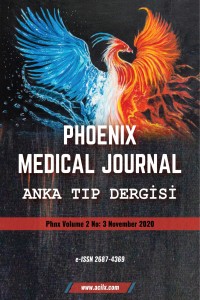Abstract
Globus pallidus ve putamen, beyindeki metabolik değişikliklere duyarlı hipervasküler yapılardır. Nonketotik hipergliseminin değerlendirilmesinde ve görüntüleme bulguları ile ayırıcı tanıda kontrastsız beyin bilgisayarlı tomografide (BBT) globus pallidus ve nukleus kaudatus da genellikle simetrik ve bilateral ancak nadiren tek taraflı hiperatenüasyon ve T1 ağırlıklı manyetik rezonans görüntülerde (MRG) bu alanlarda hiperintensite artışı izlenmektedir. Bu yazıda acil servise kore olarak tanımlanan kontrolsüz hareketlerle başvuran diyabetik hastaların görüntüleme bulgularını sunmayı amaçladık.
Supporting Institution
yok
Project Number
yok
References
- Hegde AN, Mohan S, Lath N, Lim CCT. Differential Diagnosis for Bilateral Abnormalities of the Basal Ganglia and Thalamus. RadioGraphics, 2011;31(1): 5–30.
- Hansford BG, Albert D, Yang E. Classic neuroimaging findings of nonketotic hyperglycemia on computed tomography and magnetic resonance imaging with absence of typical movement disorder symptoms (hemichorea-hemiballism). Journey of Radiology case reports. 2013;7(8):1-9.
- Wintermark M, Fischbein NJ, Mukherjee P, Yuh EL, Dillon WP. Unilateral putaminal CT, MR, and diffusion abnormalities secondary to nonketotic hyperglycemia in the setting of acute neurologic symptoms mimicking stroke. AJNR Am J Neuroradiol. 2004;25(6):975-976.
- Shan DE, Ho DM, Chang C, Pan HC,Teng MM. Hemichorea-hemiballism: an explanation for MR signal changes. AJNR Am J Neuroradiol 1998;19:863-870.
Abstract
The globus pallidus and putamen are highly vascular structures, because of that, they are more sensitive to the metabolic changes in the brain. In the evaluation of nonketotic hyperglycemia and differential diagnosis with imaging findings is in the globus pallidus and nucleus caudatus usually symmetrically and bilaterally but rarely unilaterally hyperattenuating on non-enhanced computed tomography (NECT) and hyperintensity on T1-weighted magnetic resonance images (MRI) have been reported. In this report, we aimed to present poorly controlled diabetic patients that have been admitted to the emergency service with uncontrolled movements defined as chorea.
Project Number
yok
References
- Hegde AN, Mohan S, Lath N, Lim CCT. Differential Diagnosis for Bilateral Abnormalities of the Basal Ganglia and Thalamus. RadioGraphics, 2011;31(1): 5–30.
- Hansford BG, Albert D, Yang E. Classic neuroimaging findings of nonketotic hyperglycemia on computed tomography and magnetic resonance imaging with absence of typical movement disorder symptoms (hemichorea-hemiballism). Journey of Radiology case reports. 2013;7(8):1-9.
- Wintermark M, Fischbein NJ, Mukherjee P, Yuh EL, Dillon WP. Unilateral putaminal CT, MR, and diffusion abnormalities secondary to nonketotic hyperglycemia in the setting of acute neurologic symptoms mimicking stroke. AJNR Am J Neuroradiol. 2004;25(6):975-976.
- Shan DE, Ho DM, Chang C, Pan HC,Teng MM. Hemichorea-hemiballism: an explanation for MR signal changes. AJNR Am J Neuroradiol 1998;19:863-870.
Details
| Primary Language | English |
|---|---|
| Subjects | Radiology and Organ Imaging |
| Journal Section | Case Reports |
| Authors | |
| Project Number | yok |
| Publication Date | November 1, 2020 |
| Submission Date | October 16, 2020 |
| Acceptance Date | October 23, 2020 |
| Published in Issue | Year 2020 Volume: 2 Issue: 3 |

Phoenix Medical Journal is licensed under a Creative Commons Attribution 4.0 International License.
Phoenix Medical Journal has signed the Budapest Open Access Declaration.



